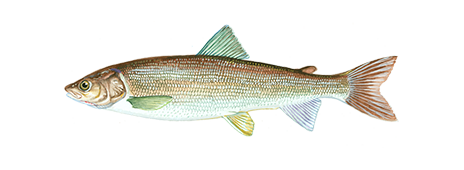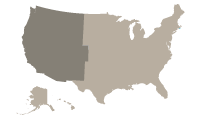
Mountain Whitefish
Though not as important as the lake whitefish, the mountain whitefish has gained some popularity as a sport fish.

Region
West
Catch ease
Easy
Habitat
Lake, River, Pond
How to identify a Mountain Whitefish
Like other salmonids, the mountain whitefish has an adipose fin and an axillary process. The mouth, however, is slightly subterminal with the snout extending clearly beyond it. The body is silvery overall. The back is brownish to olive. The scales often have pigmented borders, especially on the back. The ventral and pectoral fins may have an amber hue in adults. The body is nearly cylindrical, but not quite as cylindrical as the body of the round whitefish. It is nevertheless among the species referred to as “round whitefishes”, and is therefore distinguishable from the lake whitefish which has a laterally compressed body.
Where to catch Mountain Whitefish
The mountain whitefish is endemic to the lakes and streams of the northwestern United States and southwestern Canada, from the Lahontan basin in Nevada north to the southern border of the Yukon Territory. It occurs inland into Alberta in Canada and Wyoming in the United States. Its range overlaps that of the widespread lake whitefish in British Columbia and Alberta, and slightly overlaps that of the round whitefish in extreme northern British Columbia near the Yukon border. The following list includes additional details on where to catch this fish:
| Freshwater Lakes and Ponds |
| Holes |
| Open Water |
| Overhanging Trees and Bushes |
| Rivers and Streams |
| Rocks |
| Drop-Offs |
| Shoreline Shallows |
| Spring Holes |
| Undercuts |
How to catch Mountain Whitefish
It can be taken by fly fishing or casting with small baits. It provides a considerable winter fishery in places, particularly where steelheads are absent. The flesh is tasty and of good quality. The following are fishing methods used to catch this fish:
Mountain Whitefish lures, tackle & bait
The following are lures, tackle or bait that can be used to catch this fish:
